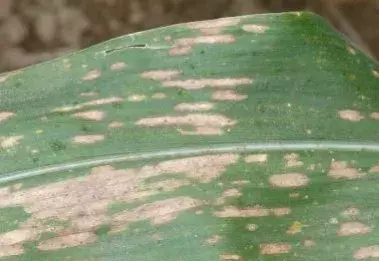Corn spot disease:
Generally, the amount of rainfall in July and the incidence of small spot disease are positively correlated, and when the disease plant rate reaches 70%, the disease leaf rate begins to develop from bottom to top; Early rainfall, early rise in the rate of diseased strains; Vice versa. When the diseased plant rate is 70% and the diseased leaf rate is 20%, if it encounters moderate to heavy rain, it will break out about 15 days. When the diseased plant rate is 100% and the diseased leaf rate is 30%, it is necessary to prevent and control it in the event of continuous rainy weather. First remove 1 to 2 diseased leaves from the bottom of the corn and destroy them centrally; Spray 50% carbendazim or 70% tolbutzin 500 times liquid, or 800 times the manganese zinc solution, or 50% dinofloxam 500 times liquid, etc.
Maize large spot disease:
Select the local main planting varieties and the corn field with good growth, take five sampling, and check the number of diseased plants, leaves per plant and severity at each point. In general, when the rate of diseased plants reaches 100% and the rate of diseased leaves is 30%, there is a rain process, and prevention and control can be carried out. Can spray 25% of the enemy power off 2000 times liquid, etc.
Corn round spot disease:
Select the disease-susceptible varieties, take five sampling points, check 10 plants at each point, check the rate of diseased plants and the number of diseased leaves per plant. Generally sprayed in the peak period of fruit ear spitting, with 25% powder rust 500 to 800 times liquid.
Corn powdery mildew:
Tumors should be removed in time.
Maize virus disease:
There are corn coarse and dwarf mosaic disease (mosaic stripe disease), the virus is transmitted by gray planthoppers and aphids, and the number of gray planthoppers and aphids in the field is closely related to the number of weeds in the field, and the number of gray planthoppers and aphids is related to the severity of the occurrence of wheat bush dwarf disease, so the incidence of corn virus disease can be judged according to the incidence of wheat bush dwarf disease. In the control, weeds and insects are mainly eliminated to prevent the serious occurrence of maize virus disease. In the field investigation, if a suspicious disease strain is found, it should be immediately removed and controlled by spraying the virus.
Corn borer:
Pay attention to the progress of egg hatching and larval harm in the field, and seize the critical period to sprinkle particles for the first generation of corn borers. Granules can be made from Bt emulsion or octyl thiophosphate emulsion to make granules, or white zombie granules can be sprinkled into the corn horn mouth to kill the hatchling larvae.
Corn lamp moth:
The main hazards to cornfields are the star white snow lamp moth, the white snow lamp moth, the sparsely lit snow lamp moth, and the human patterned sewage lamp moth. In late July, the number of eggs and larvae on 100 plants was investigated, and when 500 corn plants were found to have 2 eggs, or more than 15% of the fruit ears were bitten, the control was carried out immediately. The hatching larvae of the lamp moth have the habit of concentrating on harm, and there are more larvae after the corn spit silk, which can be organized to catch insects by hand, or spray control.
Small spot disease is a common disease on maize in the Huanghuai region, and corn can occur throughout the growth period, but the disease is most severe after the male ear is extracted. It mainly harms the leaves, forming oval spots on the leaves with reddish-brown edges and yellowish brown in the center. When the disease is severe, the leaves can be dried up early, affecting the maturity of grouting, and the grain is thin, and the weight of the thousand grains decreases and the yield is reduced.

Brown spot disease generally occurs in the mid to late stages of maize growth, forming purple spots of varying sizes on the leaf sheath and midrib. With the continuous return of straw to the field in recent years, the accumulation of germs in the soil has increased, and brown spot disease has shown a trend of early occurrence.
Corn rust mainly affects leaves, stems and bracts, but can also infect male ears. Small yellowish dots initially appear on the surface of the leaf, which later protrude and expand into rounded vesicles, and later crack. Rust not only destroys the green tissue of the leaves, but also causes a large amount of leaf moisture loss, causing premature leaf aging.
The occurrence of aphids affects the normal pollination and fruiting of corn, and the secreted honeydew contaminates the leaves, causing coal pollution disease, seriously affecting the photosynthesis of corn, resulting in yield reduction.
Corn borer larvae eat corn heart leaves and stems at the mouth of corn, which can easily cause stalk breakage. At the ear stage of maize, pests such as corn borer, peach borer borer, cotton bollworm and sorghum strip borer nibble on the grain of the fruit ear, causing corn panicle rot and affecting the yield and quality of corn.
Source: Longchi Agricultural Technical Service Center